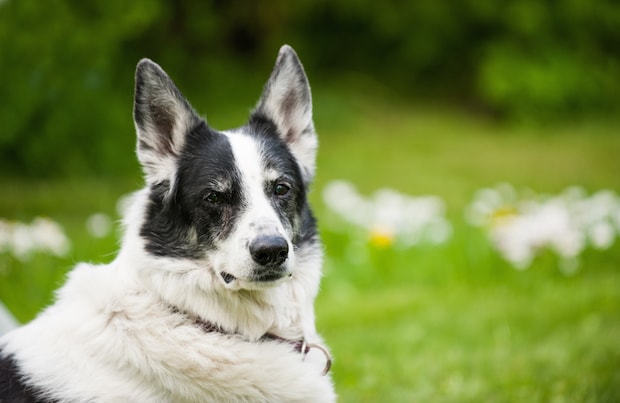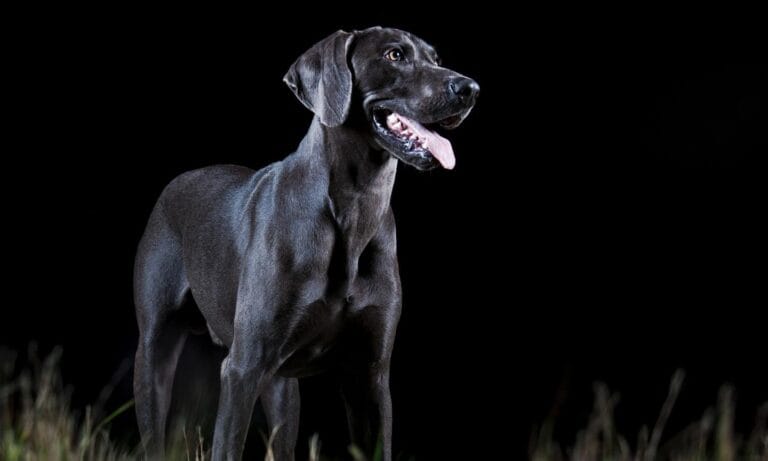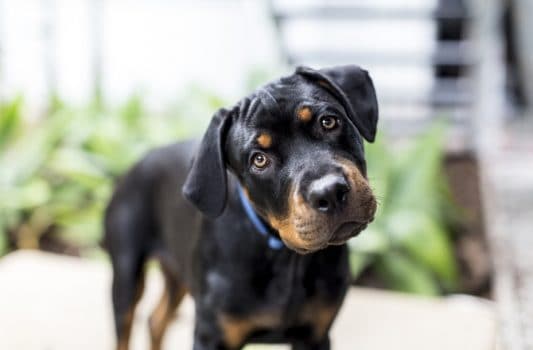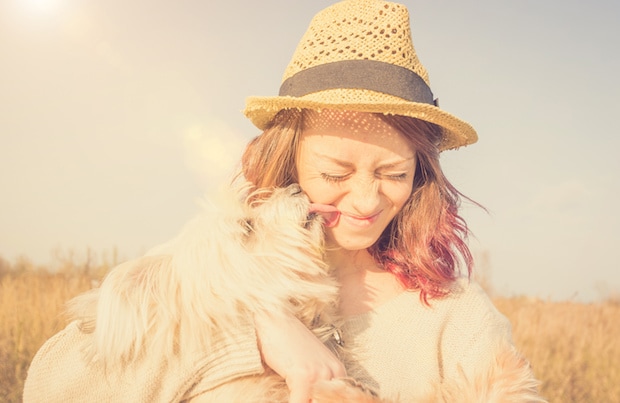The American Kennel Club currently recognizes 189 dog breeds, from the ginormous Irish Wolfhound to the tiny Italian Greyhound, and almost every imaginable size, specialty and personality in between. Although you might know a lot about your own four-legged best friend, there are so many other incredible dogs out there, with amazing backstories, rich histories or just weird characteristics (we’re looking at you, with the six toes on each paw). So here are 100 facts about 100 different breeds — and that’s just the beginning.
1. The Affenpinscher is known as the “Monkey Dog,” due to both their appearance and their personalities (Affe is German for monkey). In French, the dog is called “diablotin moustachu” — the mustached little devil.
2. The first cloned dog in history was an Afghan Hound named Snuppy. His surrogate mother was a Golden Retriever. “When an Afghan Hound comes out of a Golden Retriever, someone is tinkering with Mother Nature,” one NPR reporter joked.
3. In the 1930s, the government of Japan designated seven dog breeds as national monuments (or national treasures). The group includes the Ainu, Akita, Kai Inu, Shikoku and Shiba Inu.
4. The Airedale Terrier is sometimes called “The King of Terriers,” as it is the largest of all terrier breeds.
5. Helen Keller is believed to have brought the first Akita to the United States.
6. The Alaskan Malamute was named the state dog of Alaska in 2010.
7. The American Bulldog was on the brink of extinction after World War II, until a man named John D. Johnson worked to revive the breed. Although Johnson, who lived in Georgia, tirelessly worked to bring American Bulldogs back, his efforts are totally unrelated to the Bulldog mascot at the University of Georgia: UGA, as he’s known, is and always has been an English Bulldog.
8. American Eskimo Dogs were once popular as circus performers, as were Bichon Frises and Poodles. (Also, American Eskimo Dogs are neither American nor Eskimos; the breed originated in Germany, and was renamed after World War I).
9. But the Australian Cattle Dog has everything to do with Australia and cattle; the dog was developed by ranchers who needed a dog that had the endurance to herd cattle and travel long distances.
10. Some Australians say that “the country was built on the back of the (Australian) Kelpie” because the breed played a large role in the development of both the sheep and the wool industry.
11. And another fakeout! Australian Shepherds were actually developed by farmers and ranchers in the UNITED STATES!
12. The Azawakh is also known by the rather poetic name as “idii ’n illeli,” which translates to “sighthound of the free people.”
13. Basenjis do not bark. Although — as any Basenji owner will tell you — that does not mean they’re silent. Instead, they sort of… yodel.
14. The Barbet, a French dog, gets its name from the French word barbe, which means beard.
15. And, proving that the French really know how to name dogs, the name Basset — as in Basset Hound — loosely translates to mean “rather low.”
16. The adorably lamb-like Bedlington Terrier was named for Bedlington, a mining town in northern England.
17. In a small study conducted at a Paris hospital, a Belgian Malinois was able to sniff out prostate cancer in human urine. The trained dog was able to correctly identify 63 of 66 samples, determining which specimens were taken from men who had been diagnosed with prostate cancer, and which were from otherwise healthy individuals.
18. Snoopy, a cartoon Beagle, was named the top dog in pop culture, in a poll conducted by the American Kennel Club.
19. You thought your grandma was weird about her pumpkin pie recipe? The shepherds in the Italian Alps were so secretive about the Bergamasco, a sheep-herding dog, that they kept its bloodlines a secret.
20. The Bergamasco was also one of four dog breeds that were officially recognized by the American Kennel Club in 2015. The other three include the Boerboel, Cirneco dell’Etna and the Spanish Water Dog.
21. Bloodhounds are so impressive at tracking scents that their tracking results can be admitted as evidence in court. The most scent-sational (sorry) of all Bloodhounds was a Kentucky dog named Nick Carter, who reportedly tracked more than 600 criminals.
22. The Bolognese was a popular choice for aristocracy, including Catherine the Great of Russia and Maria Theresa, the Empress of Austria. Bolognese also appear in paintings by Titian, Goya and others.
23. The Black and Tan Coonhound is known for stealing food. He is also described as “clownish” and is reportedly difficult to handle, so I am now convinced that I have dated at least four of these.
24. The French hunting dog Bleu de Gascogne was brought to the United States in the 18th century as a gift from Frenchman and Revolutionary War ally Marquis de Lafayette to George Washington.
25. The Black Russian Terrier was developed by the Russian military by crossing everything from Giant Schnauzers and Airedale Terriers to Rottweilers.
26. According to canine researcher Dr. Stanley Coren of the University of British Columbia, Border Collies are the smartest dog breed, followed by Poodles, German Shepherds and Golden Retrievers.
27. The Border Terrier was bred to be a size that was large enough to run with horses, but small enough to scurry on the ground tracking and chasing foxes.
28. The Russian Borzoi was owned primarily by the Russian aristocracy and was rarely bought or sold; the dogs were almost always given — or received — as gifts.
29. The Boston Terrier was the first American breed recognized by the AKC and one of the first breeds created in the United States. He is the state dog of Massachusetts and the mascot of Boston University.
30. The Bouvier des Flandres, a breed that originated in Belgium, is occasionally referred to as vuilbaard, which means dirty beard. See? You don’t have it so bad, Affenpinscher.
31. Boxers are so named because of their tendency to use their front paws when fighting (or, in my experience, when trying to knock food off the counters onto the floor).
32. Some have claimed that the first Briards were brought to the United States by Thomas Jefferson in 1789. Jefferson reportedly paid the equivalent of $6 for three French dogs before he left the port of Le Havre.
33. The Bullmastiff was developed as a dog who could catch and hold poachers without hurting them.
34. A Bull Terrier named Spuds MacKenzie was the mascot for Bud Light beer in the late 1980s. It created a minor scandal when it was discovered that Spuds was really a girl dog — a girl named Honey Tree Evil Eye.
35. The English Bulldog, lovable as he is, is known for having chronic flatulence. (Enjoy that, University of Georgia).
36. A Cairn Terrier named Terry played the role of Toto in The Wizard of Oz. She was paid a weekly salary of $125, which is more than twice what the Munchkins each earned. Terry apparently had one heck of an agent.
37. The Canaan Dog, a dog native to Israel, was depicted in rock carvings from the 1st Century, and skeletons of the dogs dating back to the 5th century have been discovered. “When they talk about dogs in the Bible, it was these,” one Canaan Dog advocate told The Washington Post. “It was the same dog.”
38. Explorers have taken Canadian Eskimo Dogs on expeditions to the North and the South Poles.
39. The Catahoula Leopard Dog can climb trees, which is great for hunting or if you get your Frisbee stuck on a branch.
40. Cavalier King Charles Spaniels were used by Tudor monarchs in England as “comfort spaniels,” serving as lap dogs and foot warmers. (They even helped attract fleas from their owners. Ew!). The dogs were so closely associated with King Charles II that they became known as King Charles Spaniels.
41. The Chesapeake Bay Retriever was descended from two Newfoundland-ish puppies who were discovered on a shipwreck off the Maryland coast in 1807. The breed is now the state dog of Maryland.
42. Eleven states have state dogs; Maryland was the first to designate the Chesapeake in 1964, while Alaska was the most recent, naming the Alaskan Malamute its state dog in 2010.
43. Up to 90 percent of Chihuahuas are born with a soft spot on their heads, much like human babies have. But unlike their human counterparts, the Chihuahua’s soft spots — called molera — never completely disappear.
44. Chinese sailors often used the Chinese Crested Dogs to catch rats onboard their ships, because the hairless dogs wouldn’t catch fleas. In addition, the sailors would place the dogs on sore spots on their bodies, using them like four-legged hot water bottles.
45. The Chinook was bred into existence by one man, Arthur Treadwell Walden. The New Hampshire man was also a sled dog trainer and he took his original Chinook — who is said to be the result of breeding between Huskies and a St. Bernard mix — on Admiral Richard Byrd’s 1929 Antarctic Expedition. Sadly, the 12-year-old “original” Chinook died during the expedition; despite close calls with extinction, the breed survives today and remains the state dog of New Hampshire.
46. Chow Chows have tongues that can range from a deep purple to bluish black in color. The Chinese Shar-Pei also has a distinctive blue-black tongue.
47. Statues of dogs bearing a strong resemblance to the Chinese Shar-Pei date back to China’s Han Dynasty, more than 2,000 years ago.
48. The Collie might get its name from a derivation of the Old English word colley, which means to blacken with or as if with soot or coal. The dogs herded a kind of sheep which may have been known as colley — or black-faced — sheep.
49. Although the Coton de Tuléar is the official dog of Madagascar, he is close to extinction there.
50. Dalmatians weren’t chosen to work in firehouses just because they looked cool on the fire trucks; at one time, fire engines were drawn by horses, and the Dalmatians could keep up with the horses when they ran toward a blaze and the dogs could comfort and distract them when they got skittish around the burning buildings.
51. Dachshunds were first developed to be badger-hunting dogs. The word dachs is German for badger, so his literal name is “Badger Dog.”
52. The Dogue de Bordeaux (or French Mastiff) was almost extinct after the French Revolution. They were considered to be a dog of the upper classes, so many of them were killed.
53. The English Cocker Spaniel and the American Cocker Spaniel were considered the same breed until 1936. There’s no word on whether the American version claimed its independence on July 4.
54. There are two distinct varieties of the English Setter: one has been developed as a working dog, the other as a show dog. Weirdly enough, the show dog is the larger, heavier version.
55. Mary, Queen of Scots, is said to have had an English Toy Spaniel with her when she was beheaded. What a fun fact!
56. The Fila Brasileiro, a Brazilian dog, is said to exhibit ojeriza — a deep fear and distrust — toward strangers.
57. The Sami people (also known as Laplanders) still use the Finnish Lapphund to herd reindeer. (Perhaps it isn’t a coincidence that Rovaniemi, the capital of Finnish Lapland, is considered to be the home of Santa Claus).
58. The Finnish Spitz is the national dog of Finland. You can use that as a conversation starter the next time you have a layover in Helsinki. Or when you’re chatting with Santa.
59. George Washington was a serious dog breeder, who hoped to create a “superior” Foxhound. He bred his own variety, which he called Virginia Hounds. It has been estimated that Washington owned more than 30 Foxhounds, including one named “Sweetlips.” The Foxhound is the state dog of Virginia.
60. When laceworkers moved from England to France in the late 18th century, they took smaller bulldogs with them. The smaller bulldogs became popular and, eventually, the distinctive traits of the French Bulldog emerged (or were bred).
61. A German Shepherd named Orient helped Bill Irwin become the first blind hiker to complete the 2,100 mile Appalachian Trail.
62. The Giant Schnauzer breed was once used to guard breweries in Germany.
63. Great Danes originated in Germany, not Denmark. They are the state dog of Pennsylvania, not Denmark.
64. Great Pyrenees can be nocturnal in nature, possibly because of — or leading to — his popularity as a shepherding dog.
65. Greater Swiss Mountain Dogs were used by Swiss farmers and merchants to pull carts, but the dog’s numbers decreased significantly after the invention of the car.
66. The Greenland Dog is considered to be one of the world’s oldest breeds, dating back at least 5,000 years. The indigenous people of Greenland used the dogs to hunt seal and polar bears.
67. In the 11th century, only the nobility could own Greyhounds. If a commoner was discovered to own one of the dogs, he was severely punished — as was the dog. Greyhounds were reportedly more valuable than serfs.
68. The Havanese is the national dog of Cuba and the country’s only native breed.
69. The name of the Hovawart comes from the Middle High German for “night watchman,” which describes one of the breed’s occupations.
70. The Iceland Dog (aka Icelandic Sheepdog) was most likely brought to Iceland by viking settlers in the 9th or 10th century. It is known as the “Dog of the Vikings.” Now that’s a fierce nickname!
71. The Irish Wolfhound is the tallest of all dog breeds. The breed standard designates that he should be a minimum of 32 inches tall (30 inches for females). Many males stand 35 inches tall — almost 3 feet!
72. The Jindo has been named a national treasure of South Korea. The dog is so revered, they were included in the opening ceremonies of the 1988 Olympic Games, held in Seoul.
73. The Kai (also known as the Kai Ken or Tiger Dog) is a rare Japanese breed that is also known for its ability to climb trees.
74. The Karelian Bear Dog is used by the state of Washington and by officials at Yosemite National Park as a non-lethal way of controlling “nuisance bears” and to prevent bears from annoying — or attacking — human campers.
75. The Kuvasz’ name translates to “Armed Guard of Nobility” in Turkish. Maybe not as cool as “Dog of the Vikings,” but it still beats the heck out of “Dirty Beard.”
76. According to the AKC, the Labrador Retriever is the most popular dog breed in America, followed by German Shepherds, Golden Retrievers and Bulldogs.
77. Leonbergers were developed in the German town of Leonberg and, according to the local legend, the dog was bred to resemble the town’s lion crest. It probably would’ve been easier to, like, embroider a lion on their shirts.
78. The first Lhasa Apsos came to the United States in 1933 as a gift from the Dalai Lama to Charles Suydam Cutting, the first westerner to enter Lhasa, the forbidden city in Tibet.
79. It sounds like we’re making this up, but the Norwegian Lundehund was originally used to hunt puffin, he can climb rocks, can fold his ears shut, has six toes and can turn his head upside down. ALL OF THAT IS TRUE, SWEAR.
80. The Miniature Pinscher is not related to the Doberman Pinscher.
81. Miniature Schnauzers are part of the Terrier group, and are one of the few terriers that did not originate in Great Britain.
82. Newfoundlands are the lifeguards of the dog world. They are ridiculously strong swimmers, with water resistant coats and webbed feet.
83. The Norfolk and the Norwich Terriers were considered the same breed until 1964. The difference? Norfolk have ears that fold over, while Norwich have “prick ears” that stand up.
84. Paul McCartney owned an Old English Sheepdog and The Beatles song “Martha My Dear” was inspired by his beloved pet. (He was also the only Beatle to play on that particular song).
85. The Papillon got his name from the French word for butterfly; his characteristic fringed ears give his head a butterfly shape.
86. At one time, Pekingese could only be owned by nobility, and anyone caught stealing one of the dogs could be put to death.
87. There is an ongoing debate about whether Pharaoh Hounds have any connection to Ancient Egypt. (The dog originated in Malta). But they have been known to blush when they’re excited and many owners can train their Pharaoh Hounds to smile.
88. A Pomeranian and a Pekingese both survived the sinking of the Titanic after being carried onto lifeboats by their owners.
89. The standard Poodle was originally used as a water retriever; his name comes from the German word pudel, which means “to splash in water.”
90. Portuguese Water Dog are currently the First Dogs of the United States. President Barack Obama has two Portuguese Water Dogs, Bo and Sunny.
91. The Rhodesian Ridgeback was used to hunt lions. Read that sentence again: This dog was used TO HUNT LIONS.
92. Speaking of lions, both the Löwchen and the Pekingese are known as “little lion dogs,” due to their appearances.
93. Monks who lived at the Hospice of St. Bernard developed the dog of the same name in the 17th century. The Saint Bernards are believed to have saved the lives of more than 2,000 travelers who crossed through the mountains between Switzerland and Italy.
94. The name of the Schipperke can be translated to mean “little boatman,” but in some dialects in Brussels — where the dog originated — the word schepe means “shepherd.” Some breed enthusiasts believe that the name “little shepherd” is much more accurate.
95. The Shih Tzu and Tibetan Spaniel are amongst the breeds that are believed to have been developed to resemble the Fo (or Foo) Dog, a mythical creature that was used to guard Buddhist temples.
96. A statue of a Siberian Husky named Balto is in New York City’s Central Park. Balto was one of the sled dogs who helped deliver diphtheria treatment to Nome, Alaska in 1925. The delivery prevented an epidemic of the disease.
97. The first Tibetan Mastiffs came to the United States as gifts to President Dwight D. Eisenhower. The two dogs, a 10-month-old male and an 8-month-old female, were said to “eat four pounds of fresh meat at each meal.”
98. Tibetan Terriers were bred in monasteries and known as the holy dogs of Tibet. They were never sold, but given as gifts to bring good fortune to the recipient.
99. A Whippet named Davy is in the Guinness Book of World Records for “The Longest Flying Disc Throw Caught by a Dog.” Davy reached speeds of 40 miles per hour while he was running for that Frisbee, which is faster than I drove to buy my last Frisbee.
100. The Xoloitzcuintli (also known as the Mexican Hairless Dog) was considered to be sacred by the Aztecs and Maya, who believed him to be the animal form of Xolotl, the god of fire and lightning, who guided the sun on its nightly trip through the Underworld.
Want to learn even MORE about dogs? Visit our Dog Breeds page to get more info on 150 breeds.
By: Jelisa Castrodale
Share:









